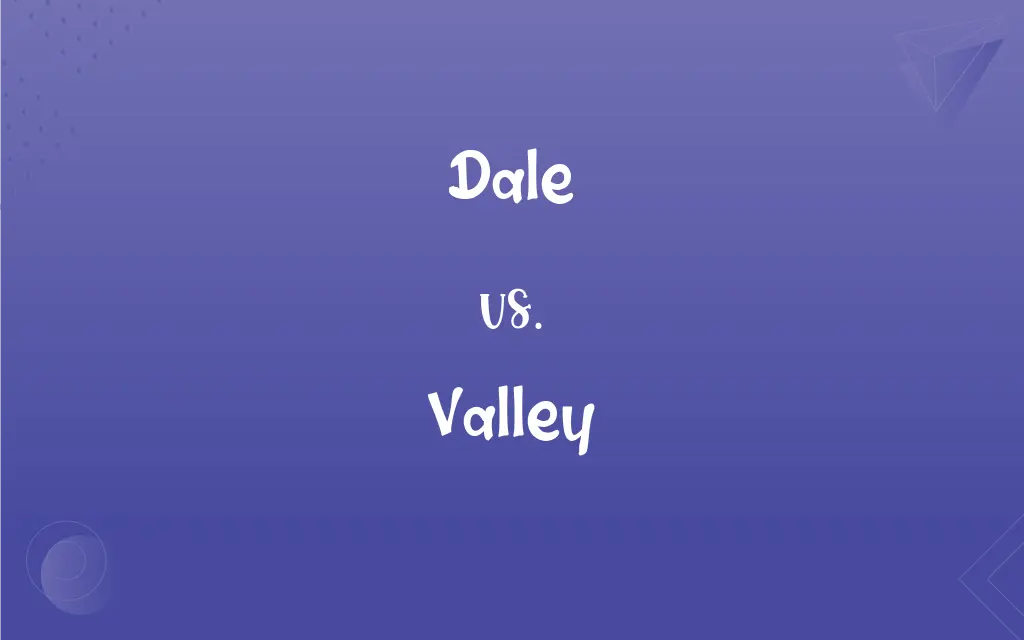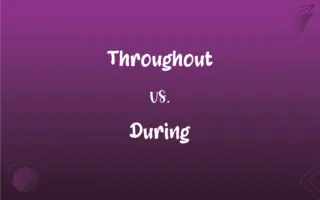Dale vs. Valley: What's the Difference?
Edited by Harlon Moss || By Janet White || Updated on October 18, 2023
"Dale" refers to a broad, natural valley, often in a rural area; "Valley" is a low area between hills/mountains, often with a river.

Key Differences
Dale" is a term that often evokes a sense of poetic or quaint rural scenery, commonly used in literature and place names. It specifically refers to an open valley that is expansive and possibly surrounded by gentle hills. In contrast, "Valley" is a more scientific term, used in geography to denote a low area of land between higher areas, often hills or mountains, which can be formed by river action or tectonic activity.
"Dales" are typically associated with natural, pastoral landscapes, often featuring in idyllic descriptions of the countryside. They're not usually characterized by extreme topographical features. However, "Valleys" can be more varied in their appearance and formation, ranging from steep, narrow gorges to wide plains, and they often accommodate rivers or streams.
The word "Dale" is somewhat archaic and is not commonly used in everyday American English conversation; it retains popularity in specific contexts and regions, like in place names in England. On the other hand, "Valley" is a widely used term in various contexts, whether discussing the physical geography of an area, in weather forecasting, or even in metaphors about emotional lows.
"Dale" often carries a sense of human-scale and accessibility, being part of pastoral landscapes that might be farmed or walked through. "Valley," while also accessible, might imply a larger, more imposing landscape that can be awe-inspiring or difficult to traverse, especially in the cases of valleys found in mountainous regions.
In literature, "Dale" might be used more in romantic, descriptive prose or poetry, its usage influenced by its Old English roots, giving a text an old-fashioned or lyrical ambiance. "Valley," meanwhile, is utilitarian and modern in its usage, fitting into a range of texts from scientific reports to contemporary fiction.
ADVERTISEMENT
Comparison Chart
Definition
Broad, open valley
Low area between hills or mountains
Connotation
Quaint, rural, possibly archaic
Standard geographical term, versatile
Usage in Literature
Poetic, old-fashioned
Varied, more modern
Common Contexts
Countryside, English place names
Geography, metaphorical lows, everyday language
Topography
Gentle, rolling landscapes
Can be gentle or dramatic, often houses rivers
ADVERTISEMENT
Dale and Valley Definitions
Dale
A low stretch of open land, often by a river.
Children played by the stream running through the dale.
Valley
An extended depression in the earth's surface.
The river cut through the valley over millennia.
Dale
A broad, open valley.
They walked through the tranquil dale as the sun set.
Valley
A low area of land between hills or mountains.
The valley was shrouded in early morning mist.
Dale
A rural valley with gentle hills.
The sheep grazed peacefully in the green dale.
Valley
A region characterized by a very low elevation.
The valley's residents were used to the cold nights.
Dale
A valley in a pastoral setting.
The cottage overlooked a flowering dale.
Valley
A place often formed by river action.
After the rain, the valley bloomed with wildflowers.
Dale
A scenic, often idyllic valley.
The painter set up his easel to capture the dale's beauty.
Valley
A metaphor for an emotional low.
She's going through a valley in her life right now.
Dale
A valley
Galloped over hill and dale.
Valley
An elongated lowland between ranges of mountains, hills, or other uplands, often having a river or stream running along the bottom.
Dale
A valley, often in an otherwise hilly area.
Valley
An extensive area of land drained or irrigated by a river system.
Dale
The sunken or grooved portion of the surface of a vinyl record.
Valley
A depression or hollow resembling or suggesting a valley, as the point at which the two slopes of a roof meet.
Dale
(archaic) A trough or spout to carry off water, as from a pump.
Valley
An elongated depression cast between hills or mountains, often garnished with a river flowing through it.
Dale
A low place between hills; a vale or valley.
Where mountaines rise, umbrageous dales descend.
Valley
An area which drains itself into a river.
Dale
A trough or spout to carry off water, as from a pump.
Valley
Any structure resembling one, e.g. the interior angle formed by the intersection of two sloping roof planes.
Dale
An open river valley (in a hilly area)
Valley
To form the shape of a valley.
Valley
The space inclosed between ranges of hills or mountains; the strip of land at the bottom of the depressions intersecting a country, including usually the bed of a stream, with frequently broad alluvial plains on one or both sides of the stream. Also used figuratively.
The valley of the shadow of death.
Sweet interchangeOf hill and valley, rivers, woods, and plains.
Valley
The place of meeting of two slopes of a roof, which have their plates running in different directions, and form on the plan a reëntrant angle.
Valley
A long depression in the surface of the land that usually contains a river
FAQs
Is "dale" a common term in American English?
No, it's less common and seen as somewhat archaic or poetic.
Is "dale" used in modern language?
It's less common and mostly used in literature or place names.
Does a "valley" always have a river?
Not always, but valleys often house river systems.
Can "valley" be used metaphorically?
Yes, it's often used to describe emotional lows.
Are "dales" exclusive to a certain region?
No, but they're commonly associated with English countryside.
Does "dale" imply a certain size?
Not specifically, but it often suggests a smaller, more accessible landscape.
Do valleys influence climate?
Yes, they can create unique microclimates.
Are valleys always surrounded by mountains?
Not always; they can also be between hills.
Can "valley" refer to urban settings?
Yes, in terms like "Silicon Valley" for tech hubs.
Can "valley" be used in weather discussions?
Yes, especially regarding temperatures or weather patterns in low areas.
Are "dales" found in mountainous regions?
They can be, but are typically associated with gentler landscapes.
Is "dale" a scientific term?
Less so; it's more poetic and used in descriptive contexts.
Are "dales" man-made?
No, they are natural landscapes.
How are valleys formed?
Often through erosive activity of rivers or tectonic movements.
Do "dales" have specific topographical features?
They're generally broad, open valleys with gentle hills.
Is "dale" a formal or informal term?
It's more formal and less commonly used in everyday speech.
Are all low areas between mountains called valleys?
Generally, though there are specific types like "gorges" or "canyons."
Can "valley" describe large geographic features?
Yes, valleys can be quite extensive.
Can "valley" have a negative connotation?
In metaphors, it can represent low points or challenges.
Does "dale" have Old English roots?
Yes, it originates from the Old English "dael," related to "dell."
About Author
Written by
Janet WhiteJanet White has been an esteemed writer and blogger for Difference Wiki. Holding a Master's degree in Science and Medical Journalism from the prestigious Boston University, she has consistently demonstrated her expertise and passion for her field. When she's not immersed in her work, Janet relishes her time exercising, delving into a good book, and cherishing moments with friends and family.
Edited by
Harlon MossHarlon is a seasoned quality moderator and accomplished content writer for Difference Wiki. An alumnus of the prestigious University of California, he earned his degree in Computer Science. Leveraging his academic background, Harlon brings a meticulous and informed perspective to his work, ensuring content accuracy and excellence.































































